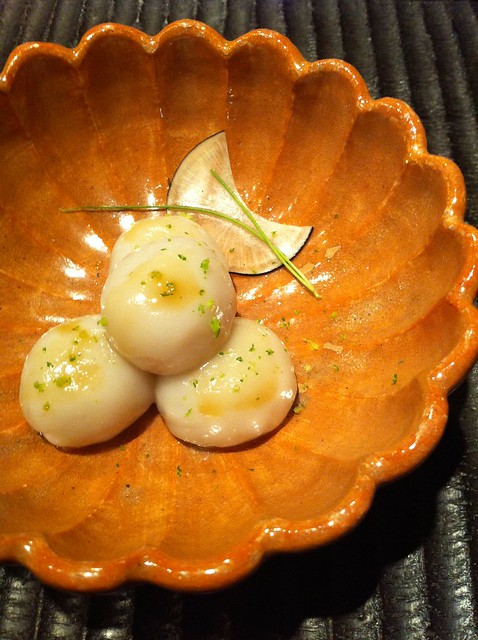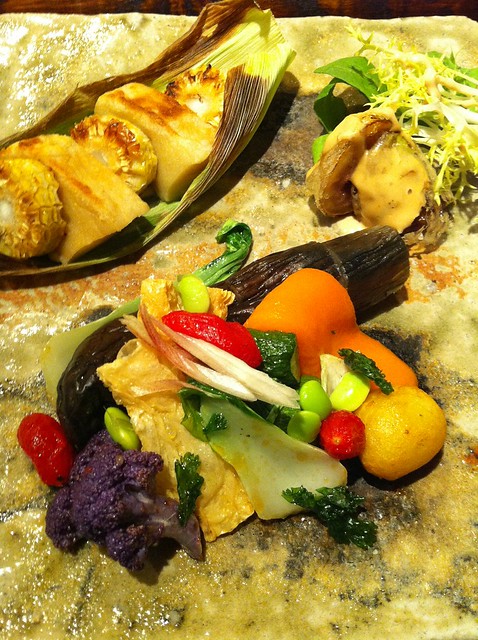414 East 9th Street between First Avenue and Avenue A
212/228.4873
about $150 for two, with drinks, without tip
♥ ♥ ♥
Kajitsu serves shojin, an ancient Japanese cuisine in which meals are prepared by following the Buddhist principle of not taking life. Leave it to Japanese culinary techniques to take a concept like vegetarianism and make it exceptional. I’ve never heard of Kajitsu before–but then again I’m rarely in the East Village–so I was glad when Erin introduced me to its serene ambiance and to vegetarian food prepared with finesse.
We sat at the bar right in front of the chef when we visited. Bar seating is a favorite of mine because you can see what’s going on behind the scenes and you have a chance to talk to the chef in between courses. There’s not much cooking going on at the Kajitsu bar though. I think they’ve perfected the assembling of ingredients prepared earlier which, if I would guess, takes the stress away from making sure each course is paced and served on time. The dishes that needed cooking came from the side door, but we rarely heard a peep so common from open kitchens. It was Zen all the way in Kajitsu.
What came out were beautifully crafted vegetable dishes that not only looked good but also tasted good. I was honestly preparing myself for another meal after our dinner because each course read more like poetry than a dish. After all, you don’t get to see “tofu chrysanthemum” on menus too often.
We imbibed in the sake martini served like shaved ice. Harmless at first, but clearly damaging after our heads reminded us that there was alcohol in those summer drinks. Our first course blew me away on presentation: taro dumplings shaped like small spheres matched with a very thinly-sliced black daikon to mimic the shape of the moon outside and then topped with chives, ginger and a hint of soy.
The tofu was sliced like a flower and floated in a light broth with two tempura-battered lobster mushrooms. I have no idea where the depth of the dish came from but I knew it wasn’t just the sake that was making me dizzy in satisfaction.
For our main courses, I opted for the hot udon soup while Erin went for the cold soba noodles, both of which were made in-house and showcased what I truly enjoy about most Japanese cuisines: clean, subtle and deceptively simple.
The most beautiful plate of cooked summer vegetables I’ve ever laid my eyes on came next. I’ll let this photo speak for itself with one note: it tasted as good as it looked.
The last course rounded up our entire experience: rice topped with yamaimo, the slimy Japanese mountain yam that I’ve always enjoyed at Sobaya, another noodle joint down the neighborhood. A trio of house-made pickles and toasted rice crispies added texture to its sliminess.
Kajitsu was what I was looking for in vegetarian food. If more vegetarian restaurants could learn from shojin cuisine, I would be very happy to stay away from meat.
Related post/s:
Kajitsu vegetarian restaurant photos on Flickr
Slimy mountain yam at Sobaya doesn’t need a long review

